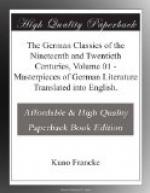Besides blank verse, the only other garb in vogue for the serious drama was prose: this was not only used for realistic pictures of conditions of a decidedly cheerful type (since Lessing had introduced the bourgeois dramas of Diderot into Germany), but also for pathetic tragedies, the vital power of which the lack of stylistic disguising of language was supposed to increase. This was the form employed in the Storm and Stress drama, and therefore in the prison scene of Faust, as also in Schiller’s youthful dramas, and again we find it adopted by Hebbel and the Young Germans, and by the naturalistic school under the leadership of Ibsen. The Old German rhymed verse found only a temporary place between these two forms. It was glorified and made almost sacrosanct by having been used for the greatest of our dramas, Goethe’s Faust; Wildenbruch in particular tried to gain new effects with it. Other attempts also went hand in hand with deeper-reaching efforts to reconstruct the inner form of the drama; thus the tendency to a veiled polyphony of language in the folk-scenes of Christian Dietrich Grabbe and in all the plays of Heinrich von Kleist; this in Hofmannsthal’s Oedipus led to regular choruses, of quite a different type, however, from those of the Bride of Messina. Gerhart Hauptmann’s Weavers and Florian Geyer may be considered the culminating points of this movement, in spite of their apparently entirely prosaic form.
Modern German drama, which in its peculiar style is still largely unappreciated because it has always been measured by its real or supposed models, is, together with the free-rhythm lyric, the greatest gift bestowed upon the treasure of forms of the world-literature by the literature of Germany which has so often played the part of recipient.
On the other hand, when speaking of the development of narrative prose, we should remember what we have already accomplished in that line. The “Novelle” alone has attained a fixed form, as a not too voluminous account of a remarkable occurrence. It is formally regulated in advance by the absolute domination of a decisive incident—as, for example, the outbreak of a concealed love in Heyse, or the moment of farewell in Theodor Storm. All previous incidents are required to assist in working up to this climax; all later ones are introduced merely to allow its




